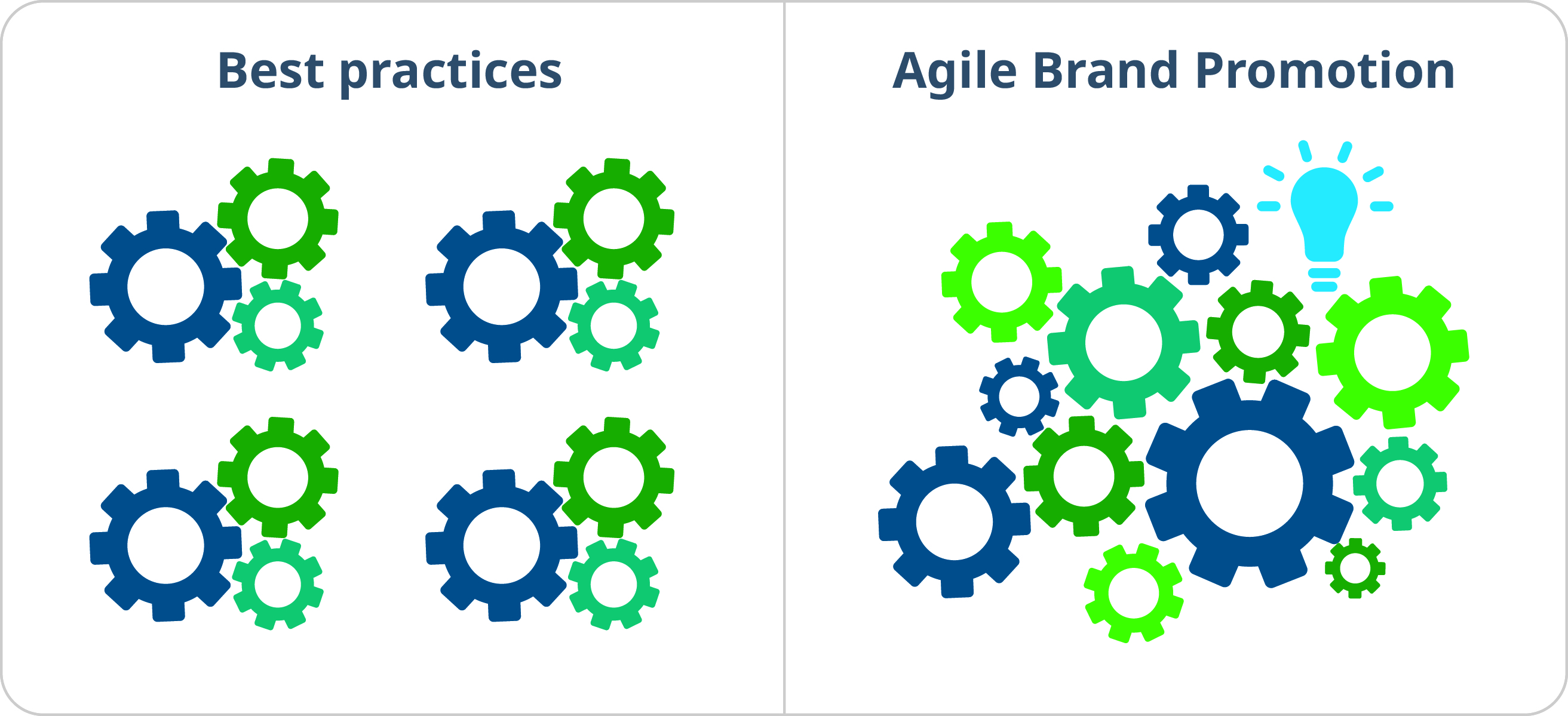We empower life sciences with connected intelligence, transforming data into actionable insights for smarter decisions and better patient outcomes.
















- Locations
- United States
- US Blogs
- Vision to Action: How Does Agile Brand Promotion Work in Practice?
In an earlier blog, we explored the need for commercial teams to embrace adaptive thinking, agile execution, and evidence-based decisions — a strategic imperative we call Agile Brand Promotion.
The foundation for this approach involves six key capabilities:
- Ready access to customer data
- Diverse, differentiated, and fit-for-purpose field roles
- Omnichannel engagement
- Local adaptation
- Hyper-personalized experiences
- Advanced analytics built to separate signal from noise
In theory, Agile Brand Promotion makes a lot of sense. Who wouldn’t want to direct resources to the patients, providers, and engagement channels that will yield the best results? But in practice, you may be skeptical. How is Agile Brand Promotion truly different from what commercial teams already do? And how, exactly, can a team initiate the evolution to Agile Brand Promotion?
Let’s take those questions one at a time.
How is Agile Brand Promotion different?
The truth is, the building blocks of Agile Brand Promotion aren’t “new.” They’re the tried-and-true elements of any promotional strategy: patient segmentation, healthcare provider (HCP) profiling and engagement, field force design and deployment, and development of omnichannel campaigns.
But Agile Brand Promotion changes the game for three reasons:
1. Connectedness. Today, commercial teams are often fragmented. Various elements of the commercial strategy are executed by different teams —using or collecting different data, managing stakeholders with different systems, and leveraging different supporting agencies.
Individual pieces of the picture might be crisp and clear. But without a holistic view across all elements of a strategy, it can be difficult to plan, manage, and pivot effectively.
Whether you’re planning a launch, preparing for loss of exclusivity, or working to improve performance of an established therapy, Agile Brand Promotion introduces an unprecedented level of connectedness across virtually every aspect of commercial execution. It acknowledges the complex and dynamic interdependencies across patients and HCPs, as well as the channels through which brands engage them.
With this greater connectedness, it becomes possible to identify the patients most likely to be diagnosed with the relevant condition; the HCPs most likely to prescribe the treatment to those patients (and/or influence others to do so); and the mix of personal (human) and non-personal (digital) channels best suited to engaging patients, providers, and other stakeholders for return on promotional investment.

2. Currency. What seems effective on paper doesn’t always translate into success in practice. Too often, brand teams are unable to quickly identify the “why” of sub-optimal performance. Data may arrive too late or in so many pieces and parts that, once again, it’s difficult to discern the “big picture.”
A core component of Agile Brand Promotion is rapid access to data-driven insights. With current, accurate, holistic analytics, teams can adjust quickly enough to make an impact on an individual customer’s experience or commercial performance of the brand as a whole.
Adjustments may include diverting resources to HCPs who are more receptive to the treatment and away from those who are not responding to digital. It may involve reducing the focus on the field force in an area where HCPs are responding well to digital engagement — and redeploying your human resources to localities with return on promotional investment. Or it could lead to an increase across functional lines on patient support to get over the reimbursement hurdle.
3. Confidence. With a foundation of connected, current data, Agile Brand Promotion enables teams to have confidence as they make decisions. This is where IQVIA has something to promote: an unmatched portfolio of data assets and unique strengths in harnessing these resources with speed and agility. The power lies not just in the individual data sets but in the insights that emerge when we bring them together in a compliant and actionable way.
Confidence comes when you have such robust patient data that you can predict which channels a target audience is likely to respond to. It comes when you can surface “hidden” thought leaders and map their spheres of influence in their local communities. Confidence is leveraging and prioritizing field triggers with intelligent selections that explain why, combined with a reporting platform that caters to high performers or simplifies for new hires.
In short, Agile Brand Promotion is an infusion of connectedness, currency, and confidence into traditional commercial activities. And, as explained in the first blog, it’s an evolution — not an overnight makeover.
How, exactly, can a team initiate the evolution to Agile Brand Promotion?
The answer to this one is easy: just about anywhere you want.
We’ve devised suggested first steps for all six core capabilities of Agile Brand Promotion. So, start where you believe you have the greatest opportunity for positive change, and then grow from there. The prompts that follow may help in assessing strengths and weaknesses and identifying your own “next best actions.”
Connected, convenient customer data. How well is your organization collaborating to source, master, and manage commercial data to respond to changing customer needs? Are you dynamically collecting data with enough speed to alter how you engage a customer?
Diverse, differentiated field roles. Have you designed customer-facing roles tailored for specific customers, TA, or local market needs? Are you appropriately balancing face-to-face, virtual, and hybrid roles to drive better access to HCPs?
Omnichannel engagement. Does your promotional mix modeling
- include in-depth customer information on preferences, access, and institutional settings,
- consider personal and non-personal interactions, and/or
- include real-time updates?
Adaptive allocation. Can your digital and/or field tactics be altered at a sub-national level to meet local market dynamics over time? How well does your commercial model adapt to channel preferences, HCP feedback, local market dynamics, and desired message sequencing?
Hyper-personalized experience. Is your engagement strategy tailored to where customers are in their learning journey about your product? How have you planed for the fact that different customers prefer different messages in content through different channels at different times?
Advanced analytic decision-making. Are you taking full advantage of AI/ML to inform the next best actions for customers? Do your analytics drive the right number of triggers or alerts for your digital and field engagement?
Start building a well-oiled commercial machine
As the pace and complexity of change continues to increase, grinding through the status quo isn’t an option for any brand that wants enduring success. Agile Brand Promotion offers a blueprint for change — and an opportunity to start small and evolve over time.

Promotional Darwinism: Achieving Brand Goals via Speed to Insight and Agile Execution
Upending years of baked-in approaches to budgeting, planning, and executing brand plans to adopt a new engagement model may feel risky. But, the alternative — failing to adjust to the new commercial reality — is perilous indeed. We believe that deploying Agile Brand Promotion is now a strategic imperative for survival.
In our latest white paper, we share our vision of Agile Brand Promotion and explore the fundamentals necessary to achieve it.
Related solutions
Deploy sales representatives, clinical nurse educators, field reimbursement specialists virtually or in the field to communicate the benefits of your therapy.
Data, AI, and expertise empower Commercial Solutions to optimize strategy, accelerate market access, and maximize brand performance.




